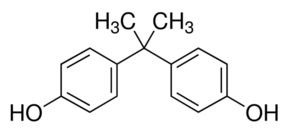HI! I’M ELEMENT AI.
Bisphenol A

Product Description
Bisphenol A (BPA) is a chemical used primarily in the production of polycarbonate plastics.
Product:
Bisphenol A
CAS:
80-05-7
Synonym:
2,2-Bis(4-hydroxyphenyl)propane; 4,4′-Isopropylidenediphenol
Structure:

Typical Characteristics
Appearance
White to light brown flakes or powder
Boiling point
250–252 °C
Density
1.195 g/cm3
Flash Point
227 °C
Melting point
158 - 159 °C
Molecular Weight
228.29
Odor
Phenolic odor
Purity
≥99 %
Refractive index
1.5542
Uses, Applications & Markets
Key applications
get a quote



Bisphenol A used in many
industry applications
Bisphenol A (BPA) is a chemical compound with various industrial applications. Here's a list of some of its uses:
- Polycarbonate Plastics: BPA is primarily used in the production of polycarbonate plastics, which are widely used in consumer products such as water bottles, food containers, eyeglass lenses, and electronic devices. Polycarbonate plastics are valued for their transparency, durability, and heat resistance.
- Epoxy Resins: It is used as a monomer in the production of epoxy resins, which are used as coatings, adhesives, and sealants in various applications. Epoxy resins derived from BPA exhibit excellent adhesion, chemical resistance, and mechanical properties.
- Food and Beverage Packaging: BPA-based materials are commonly used in food and beverage packaging, including cans, bottle caps, and food storage containers. They help protect food and beverages from contamination, extend shelf life, and maintain product freshness.
- Medical Devices: BPA-containing materials are used in the manufacture of medical devices, such as syringes, catheters, and intravenous tubing. They are valued for their biocompatibility, transparency, and sterilizability, making them suitable for medical applications.
- Consumer Electronics: BPA-based plastics are used in the production of consumer electronics, including smartphones, laptops, and electronic housings. They provide structural support, impact resistance, and electrical insulation in electronic devices.
- Automotive Parts: BPA-containing materials are used in automotive applications, such as interior trim, dashboards, and headlight lenses. They offer durability, heat resistance, and dimensional stability in automotive components.
- Construction Materials: BPA-based materials are used in construction applications, including window glazing, roofing, and insulation. They provide strength, weather resistance, and thermal insulation in building materials.
- Sports Equipment: BPA-containing plastics are used in the production of sports equipment, such as helmets, protective gear, and eyewear. They offer lightweight, impact-resistant, and durable properties in sports gear.
- Electrical and Electronic Components: BPA-based materials are used in electrical and electronic components, such as connectors, switches, and circuit boards. They provide electrical insulation, heat resistance, and dimensional stability in electronic devices.
- Aerospace Applications: BPA-containing materials are used in aerospace applications, including aircraft interiors, cabin components, and structural panels. They offer lightweight, flame resistance, and mechanical strength in aerospace materials.